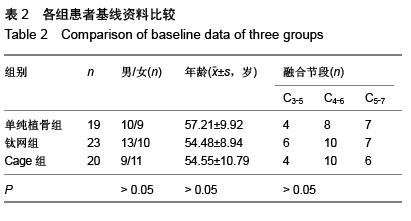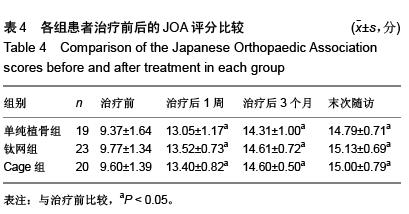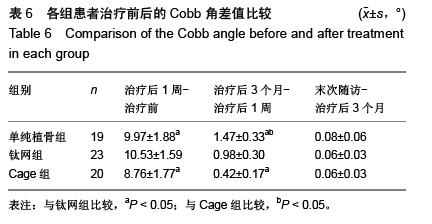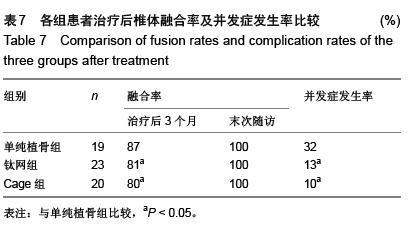| [1] Emery SE. Anterior approaches for cervical spondylotic myelopathy: which? When? How? Eur Spine J. 2015;24(2): 150-159.
[2] Matz PG, Pritchard PR, Hadley MN. Anterior cervical approach for the treatment of cervical myelopathy. Neurosurgery. 2007;60(1): S64-70.
[3] 章波,唐龙,杨波, 等.多节段脊髓型颈椎病的手术治疗:三种手术方法的初期临床疗效比较[J].中国矫形外科杂志,2015, 23(1): 5-11.
[4] Smith GW, Robinson RA. The treatment of certain cervical-spine disorders by anterior removal of the intervertebral disc and interbody fusion. J Bone Joint Surg Am. 1958; 40(3): 607-624.
[5] Korinth MC. Treatment of cervical degenerative disc disease - current status and trends. Zentralbl Neurochir. 2008;69(3): 113-124.
[6] 陈奋勇,李建东,宋建榕,等.颈前路手术治疗多节段颈椎间盘突出症[J].福建医科大学学报, 2008, 6(42): 554-555.
[7] 姜永庆,张挺,董大明,等.钛网联合Cage配合自锁钛板治疗多节段颈椎间盘突出症[J].中国修复重建外科杂志, 2008, 22(8): 897-900.
[8] 高延征,王红强,刘涛.多节段颈椎间盘突出症的术式选择[J].中国矫形外科杂志, 2007,15(13): 961-963.
[9] Moon HJ, Kim JH, Kim JH, et al. The effects of anterior cervical discectomy and fusion with stand-alone cages at two contiguous levels on cervical alignment and outcomes. Acta Neurochir (Wien). 2011;153(3): 559-565.
[10] 宋科冉,袁文,王新伟,等.椎体次全切除与椎间隙减压治疗多节段颈椎病的疗效比较[J].脊柱外科杂志, 2011, 9(2): 102-107.
[11] 刘世敬,张景僚,袁国栋,等. 3种颈椎前路减压重建方式对稳定性影响的生物力学研究[J].中国矫形外科杂志, 2011,19(17): 1459-1462.
[12] Demircan MN, Kutlay AM, Colak A, et al. Multilevel cervical fusion without plates, screws or autogenous iliac crest bone graft. J Clin Neurosci. 2007;14(8): 723-728.
[13] Cho DY, Lee WY, Sheu PC. Treatment of multilevel cervical fusion with cages. Surg Neurol. 2004; 62(5): 378-385.
[14] Nikaido T, Kikuchi S, Yabuki S, et al. Surgical treatment assessment using the Japanese orthopedic association cervical myelopathy evaluation questionnaire in patients with cervical myelopathy: a new outcome measure for cervical myelopathy. Spine (Phila Pa 1976). 2009;34(23): 2568-2572.
[15] Ariga K, Miyamoto S, Nakase T, et al. The relationship between apoptosis of endplate chondrocytes and aging and degeneration of the intervertebral disc. Spine. 2001;26(22): 2414-2420.
[16] Yoshida M, Tamaki T, Kawakami M, et al. Indication and clinical results of laminoplasty for cervical myelopathy caused by disc herniation with developmental canal stenosis. Spine. 1998;23(22): 2391-2397.
[17] Clarke E, Robinson PK. Cervical myelopathy: a complication of cervical spondylosis. Brain. 1956;79(3): 483-510.
[18] 任先军,焦文仓,张年春,等.颈椎前融合保留终板的骨愈合观察[J]. 中国矫形外科杂志, 2002, 9(6): 542-546.
[19] 张年春,任先军,张峡,等.保留终板的颈椎前路融合术术后融合节段高度变化小[J]. 创伤外科杂志, 2003, 5(4): 247-251.
[20] Oh MC, Zhang HY, Park JY, et al. Two-level anterior cervical discectomy versus one-level corpectomy in cervical spondylotic myelopathy. Spine. 2009; 34(7): 692-696.
[21] 刘勇,陈亮,顾勇,等.两种前路减压植骨融合并钛钢板置入内固定治疗相邻两个节段脊髓型颈椎病的比较[J].中国组织工程研究与临床康复, 2011, 15(4): 597-601.
[22] 张伟, 陈德玉,杨立利,等.两种颈椎前路减压融合术治疗脊髓型颈椎病的临床疗效分析[J].中国矫形外科杂志, 2011, 19(3): 181-183.
[23] Liu J, Chen X, Liu Z, et al. Anterior cervical discectomy and fusion versus corpectomy and fusion in treating two-level adjacent cervical spondylotic myelopathy: a minimum 5-year follow-up study. Arch Orthop Trauma Surg. 2015;135(2): 149-153.
[24] Barbagallo GM, Romano D, Certo F, et al. Zero-P: a new zero-profile cage-plate device for single and multilevel ACDF. A single institution series with four years maximum follow-up and review of the literature on zero-profile devices. Eur Spine J. 2013;22(6): 868-878.
[25] Chen Y, Chen H, Cao P, et al. Anterior cervical interbody fusion with the Zero-P spacer: mid-term results of two-level fusion. Eur Spine J. 2015;24(8): 1666-1672.
[26] 管华清,杨惠林,姜为民,等.新型零切迹桥形锁定融合器治疗脊髓型颈椎病的早期疗效[J]. 中国矫形外科杂志, 2015, 23(9): 794-799.
[27] Park Y, Maeda T, Cho W, et al. Comparison of anterior cervical fusion after two-level discectomy or single-level corpectomy: sagittal alignment, cervical lordosis, graft collapse, and adjacent-level ossification. Spine J. 2010;10(3): 193-199.
[28] Asl?er M, Do?an E, Ecevit MC, et al. The treatment of pharyngoesophageal perforation following anterior cervical spine intervention. Auris Nasus Larynx. 2015. pii: S0385- 8146(15)00233-3.
[29] Salvatori-Rubí JJ, Montiel-Jarquín AJ, Barragán-Hervella RG, et al. [Cervical arthrodesis by means of interbody fusion with autologous bone and/or interbody spacer for cervical disc disease]. Acta Ortop Mex. 2014;28(5):273-276.
[30] Cincu R, Lorente Fde A, Gomez J, et al. Long term preservation of motion with artificial cervical disc implants: A comparison between cervical disc replacement and rigid fusion with cage. Asian J Neurosurg. 2014;9(4):213-217.
[31] Li J, Li Y, Kong F, et al. Adjacent segment degeneration after single-level anterior cervical decompression and fusion: disc space distraction and its impact on clinical outcomes. J Clin Neurosci. 2015;22(3):566-569.
[32] Kao TH, Wu CH, Chou YC, et al. Risk factors for subsidence in anterior cervical fusion with stand-alone polyetheretherketone (PEEK) cages: a review of 82 cases and 182 levels. Arch Orthop Trauma Surg. 2014;134(10): 1343-1351.
[33] Boudissa M, Castelain JE, Boissière L, et al. Conversion paralysis after cervical spine arthroplasty: a case report and literature review. Orthop Traumatol Surg Res. 2015;101(5): 637-641.
[34] Si W, Zhang H, Wang A, et al. [Clinical research of dynamic cervical implant and cage fusion in two-level cervical disc protrusion]. Zhongguo Xiu Fu Chong Jian Wai Ke Za Zhi. 2014;28(1):60-63.
[35] Zagra A, Zagra L, Scaramuzzo L, et al. Anterior cervical fusion for radicular-disc conflict performed by three different procedures: clinical and radiographic analysis at long-term follow-up. Eur Spine J. 2013;22 Suppl 6:S905-909. |
.jpg)






.jpg)
.jpg)